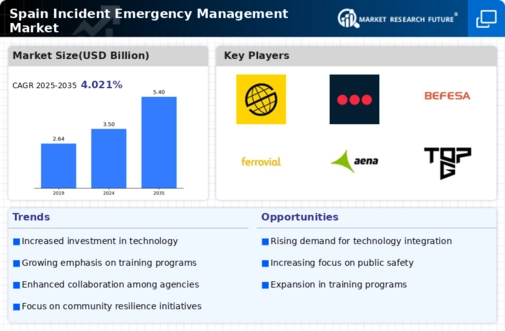Rising Urbanization
The rapid urbanization in Spain is a crucial driver for the incident emergency-management market. As cities expand, the complexity of managing emergencies increases, necessitating advanced systems and protocols. Urban areas, which house over 80% of the population, face unique challenges such as higher population density and infrastructure vulnerabilities. This urban growth has led to a projected increase in the market size, with estimates suggesting a growth rate of approximately 6.5% annually. Consequently, municipalities are investing in incident management technologies to enhance response times and improve public safety. The incident emergency-management market is thus positioned to benefit from these investments, as local governments seek to implement more effective emergency response strategies.
Climate Change Adaptation
The impact of climate change is becoming increasingly evident in Spain, driving the need for effective incident emergency-management strategies. With rising temperatures and more frequent extreme weather events, such as floods and wildfires, the incident emergency-management market is under pressure to adapt. Recent studies indicate that Spain could experience a 20% increase in emergency incidents related to climate change by 2030. This necessitates the development of specialized response plans and technologies tailored to these challenges. As a result, stakeholders are likely to invest in advanced forecasting tools and training programs, thereby expanding the market and enhancing overall preparedness.
Increased Investment in Public Safety
In Spain, there is a growing emphasis on public safety, which significantly influences the incident emergency-management market. Government budgets are increasingly allocated towards enhancing emergency response capabilities, with a reported increase of 15% in funding for emergency services over the past three years. This trend reflects a broader recognition of the need for robust incident management systems to protect citizens and infrastructure. The incident emergency-management market is likely to see further growth as public safety initiatives expand, leading to the adoption of innovative technologies and training programs. This investment not only improves response times but also fosters community resilience against various emergencies.
Public Awareness and Training Programs
There is a notable increase in public awareness regarding emergency preparedness in Spain, which serves as a significant driver for the incident emergency-management market. Educational initiatives and training programs aimed at equipping citizens with essential skills are gaining traction. Reports indicate that participation in community training programs has risen by 25% over the last two years. This heightened awareness not only empowers individuals but also alleviates pressure on emergency services during incidents. Consequently, the incident emergency-management market is likely to expand as organizations invest in resources to support these educational efforts, fostering a culture of preparedness and resilience.
Technological Advancements in Communication
Advancements in communication technologies are reshaping the incident emergency-management market in Spain. The integration of real-time data sharing and mobile applications has revolutionized how emergency services operate. Enhanced communication systems enable quicker decision-making and more efficient resource allocation during incidents. Recent data suggests that the adoption of these technologies has improved response times by up to 30%. As emergency management agencies increasingly rely on these innovations, the incident emergency-management market is expected to grow, driven by the demand for more effective communication tools and platforms that facilitate collaboration among various stakeholders.


















Leave a Comment